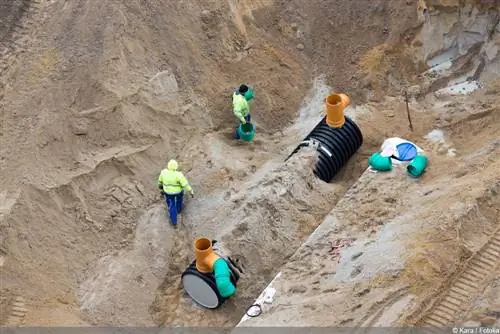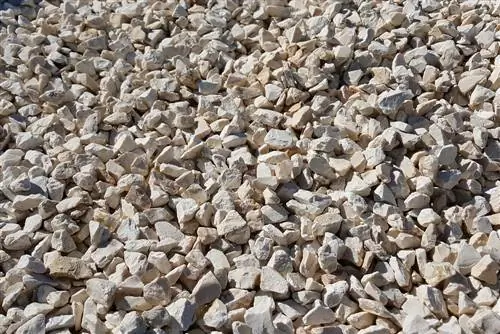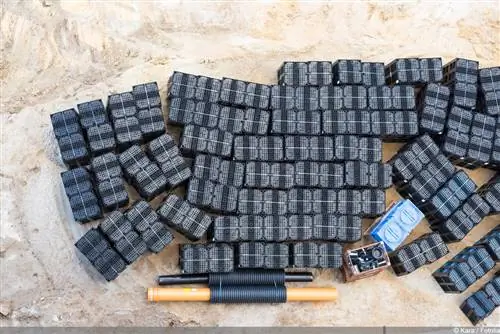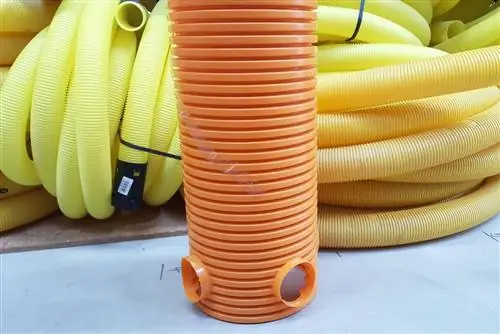- Author admin [email protected].
- Public 2023-12-17 03:39.
- Last modified 2025-01-24 12:45.
Climate change is on everyone's lips and can no longer be denied. Meteorologists warn of more frequent heavy rains and long wet and dry seasons. For hundreds of years, people have been regulating the water balance in the soil with the help of seepage packs, also known as drainage. This creates dry areas in which excess water can collect and be drained away in a controlled manner.
How drainage drains work
The oldest reports of drainage come from the Babylonian Empire. The Romans initially used ditches with stones and bushes to drain swamps and protect their roads from water damage. The principle of drainage through drainage or seepage packing has remained the same to this day. By creating open or backfilled trenches, you create dry areas in the ground where excess water can collect. Drainage exploits the physical property of liquids to flow from wet to dry areas. Since this only works in conjunction with gravity, an appropriate gradient must be created towards the drainage ditches. There the drainage pipe drains the water as quickly as possible into a receiving water. After some time, the interaction of cohesion and adhesion forces causes a constant flow of water in the drained soil.
Identifying and analyzing causes
Three main causes result in soil waterlogging and thus damage to gardens, plants and buildings. In order to successfully prevent and eliminate water damage, it is fundamentally important to be able to identify these causes. If the existing soil is very cohesive with a high proportion of silty and clayey components (soil components smaller than 1 mm), it only absorbs water slowly and holds it for a long time. If the gradient is too slight or the surface is flat, the water will build up.
In regions with high groundwater levels, it can happen that the foundation and floor slab of the house are constantly surrounded by groundwater. The result is rising moisture into the walls. Another form of waterlogging is caused by structures that prevent the natural flow of water (walls, streets).
Tip
- determine where the excess water comes from
- Model the surface evenly
Take the right action
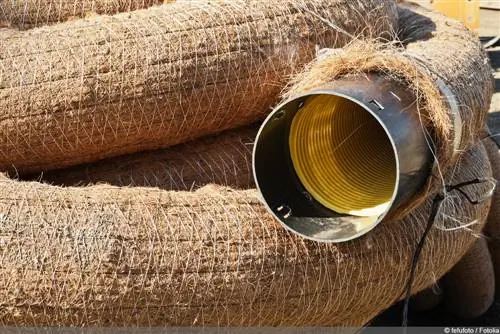
Waterlogging caused by structures is easy to eliminate. Installing a seepage pack directly in front of the structure at a depth of around 30-40 centimeters is sufficient. The gradient of the drainage pipe should be 0.5 to a maximum of 1.0 percent. If water remains on the surface, it must first be ensured that this surface has a clear surface slope. Depending on the lateral options, choose at least a two to four percent gradient. (Two to four centimeters difference in height per meter of length). If a panel slope in one direction is not possible, a roof slope can also be implemented. Drainage pipes are now laid across the surface slope at a distance of two to four meters (depending on the nature of the soil) (so-called suction pipes). Here the depth should be no more than 30-40 centimeters. The suction cups flow into a collecting line, the so-called collector.
Protect buildings from water damage over the long term
In order to permanently drain high groundwater from the floor slab and the foundations of the house, it is necessary to install the drainage pipe slightly below this floor slab. The cable is laid directly on the outside wall around the entire building. Installation depths of 60 to 80 centimeters are not uncommon. Since this work is very complex and expensive, it should be carried out during the construction phase if possible. This measure is particularly effective if the trench is filled to the top with gravel or something similar. This means that surface water can reach the drainage pipe and be drained away directly via the shortest route. The house wall can breathe. A chic look can be achieved by using coarse gravel or gravel as the top layer.
Professional installation?
When the infiltration trench is created, the bottom of the trench must have a longitudinal gradient of 0.5 to 1.0 percent. The drain pipe is now laid directly on the bottom of the trench and the trench is filled with water-permeable material. (Details about the material below). The pipes are connected to the existing rainwater pipe (downpipe or similar) so that the water can drain away. It would be ideal to discharge the water into receiving waters such as streams, ditches or other surface water. If the drainage ditches run through lawns, they should be covered with sandy topsoil. A layer thickness of 15 centimeters is enough to allow the lawn to grow well again. It is very important to install a filter fleece between the topsoil and the water-permeable material. This prevents the lawn from sinking and the drainage from becoming muddied.
Tip
- Always lay drainage ditches perpendicular to the surface gradient
- Lay drainage directly in front of structural obstacles
- Drainages must always have a functioning drain
- Separate topsoil and drain material using filter fleece
Special cases with difficult height connections?
Most properties are located in settlements with directly adjacent neighbors. Here the connection heights are fixed by the surrounding terrain. It is therefore often not possible to model the terrain in such a way that the surface water can be channeled with a natural gradient. In these cases, the building contractor must install a drainage shaft at a suitable location (power connection, short cable routes). This collects the water absorbed through the drain pipes. A pump with an automatic “float switch” pumps it into the higher rain sewage pipes.
Suitable materials
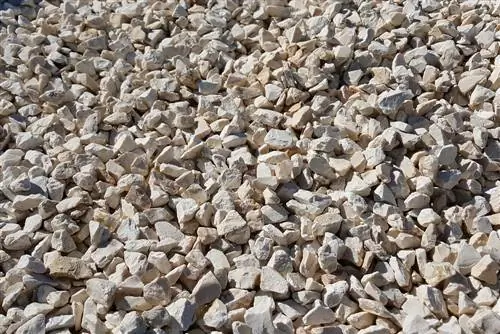
The type of material used to fill the seepage pack depends heavily on regional availability. It is not important whether you use gravel, crushed stone or granules. The decisive factor is the strong drainage ability, i.e. water permeability of the installed material. Therefore, no components smaller than one millimeter may be present in it. It is also possible to use materials with different grain sizes. The so-called filter rule must be applied. It says that the grain sizes must always increase upwards. This prevents small particles of grain from falling into the cavities of the coarse grains underneath due to gravity.
Tip
- never backfill the trench with the same excavation
- only use coarse-grained material without 0 components
Material list:
- Filter gravel 2-8 mm or 16-32 mm
- Gravel 16-32 mm
- Glass granules from blast furnaces 2-8 mm or 8-16 mm
- Filter fleece to protect against siltation
- Slotted drain pipes with or without coconut coating
- Slotted drain pipes with flat, closed bottom part (faster water drainage)
- Plastic collection shafts with up to three inlets
Maintenance
Professional craftsmanship and technical execution is the foundation for a long-term functioning seepage pipe. However, drainage cannot function entirely without maintenance and care. During installation, a flushing opening should be provided on each drainage line (inspection pipe). At least every two years, the pipe must be flushed with a suitable nozzle and freed of deposits. The same applies to the seepage shaft. A regular functional check of the pump protects against unpleasant surprises.
Tip
- Provision for flushing openings during installation
- perform regular maintenance
Prices for material and execution
The material prices depend heavily on the region and the quantity required and can only be a rough guide. There is a volume discount when purchasing entire rolls (50 m). For heavy materials such as gravel, regional availability and transport route are crucial for the price. High-quality filter fleece is available in rolls in various lengths and widths. Here too, purchasing entire packaging units is cheaper than a cut. If the work is carried out by a specialist company including material deliveries and disposal of the excavation, you must expect a price per meter of around 35-50 euros for the finished work.
- PVC solid seepage pipe, depending on diameter from 1.75 EUR/m
- Same pipe with coconut fibers as a filter layer from 2.80 EUR/m
- Drain gravel 2/8 mm or 16/32 mm from 60.00 EUR/ton. (1 m³ corresponds to approximately 1.70 tons.)
- Filter fleece, depending on quality and thickness from 0.85 EUR/m2
- Inspection shaft, depending on diameter from 70.00 EUR/piece

